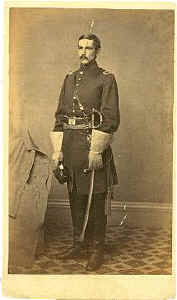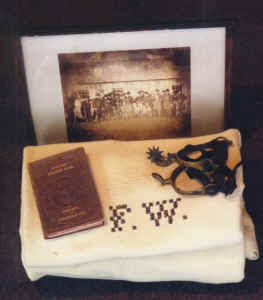|
Francis Washburn and the California Hundred were as distant and different as
Boston and San Francisco. Washburn was a blueblooded Boston Brahmin. He
was as close to American aristocracy as it gets. The impetuous,
free-spirited men of the Hundred were… not. Yet over time, Washburn
and the Californians developed a high respect for each other.
Washburn came to the 2nd Massachusetts Cavalry with some serious
military experience. He had already learned the hard realities of combat
and military life with the 1st Mass. Cavalry. He enlisted in
this well-connected regiment in 1861 as a 21-year-old shavetail
lieutenant from Harvard University’s Lawrence Scientific School. When
the 2nd Mass. Cavalry was organized, he accepted the
captaincy of Company D (Massachusetts men, of course). After all,
promotion is good.
By in large, the Californians held their highbrow Bay State officers in low
regard. But time and service together helped close the gap. When Captain
James Sewell Reed, commander of the California Hundred, rose to the
command of the first battalion in August, 1863, Washburn took command of
Company A. One of his men, Thomas Barnstead, reported to a California
newspaper, “a Massachusetts man, is now our Captain, and, so far, is
liked very well.” Others felt the same about Washburn. One of the
Massachusetts officers recalled that Washburn, “proved one of the best
officers of the line.” In camp, he exercised a level of fairness that
struck home with the Californians. In the field, he led from the front.
Enough said.
In February 1864, opportunity reached out again. Washburn was
mustered in as lieutenant colonel of another new regiment — the 4th
Massachusetts Cavalry. A year later, Washburn was promoted full colonel.
His regiment was part of the Army of the Potomac’s stranglehold on
Petersburg and Richmond when Lee abandoned his fortifications in a last,
desperate move to save his army. Washburn was sent with a force of
cavalry and infantry on April 6, 1865 to destroy the bridge at High
Bridge, Virginia before the enemy could escape across it. The union
troops reached the bridge just as the confederates did.
In an impetuous charge, Washburn and less than 100 cavalrymen,
backed by 800 infantrymen, took the bridge and cut their way right into
the main force of the Army of Northern Virginia. Hundreds of confederate horsemen swarmed into the
melee. According to family history, the rowel of one of his spurs was
snapped off by a bullet or canister ball during the charge.
In the swirling, hand-to-hand combat, Washburn became engaged in a saber
duel with confederate Brigadier General James Dearing. This personal
clash was cut short when Washburn was shot through the cheek by a rebel
cavalryman. Falling from his horse, he then received a severe saber blow
to his skull. It was over. The twice-wounded colonel was brought back to
friendly lines. Most of the other surviving yanks were captured. The
outnumbered federals lost heavily and were unable to destroy the bridge.
But as a result of their audacious assault, Lee expected a larger force
behind them. So he halted his advance, giving time for the 24th
Corps to cut off the confederate retreat.
Washburn was mortally wounded. A brevet brigadier general’s
commission was rushed through channels, based on his recent gallantry.
He held on to life through Lee’s surrender at Appomattox. And through
Lincoln’s assassination. He held on through the long, painful,
jouncing, bouncing, journey to his brother’s home in Worcester. But
the young, tall, delirious, dying, strikingly handsome, horribly maimed
and unquestionably brave Francis Washburn finally, mercifully died of
his wounds on April 22, 1865. His connections to the California Hundred,
the 2nd Massachusetts Cavalry and all others were now
history.
###
Image
and text courtesy of Richard K. Tibbals
|

